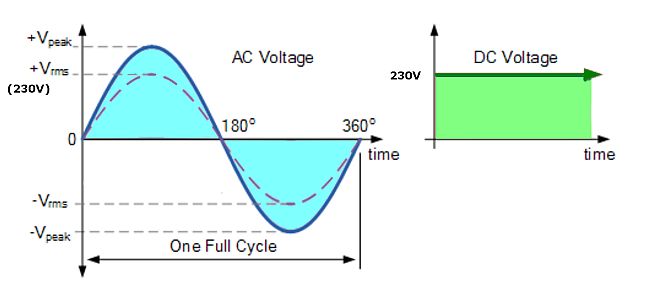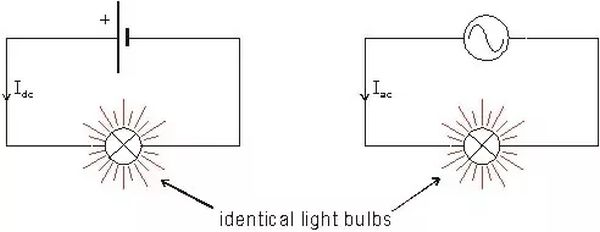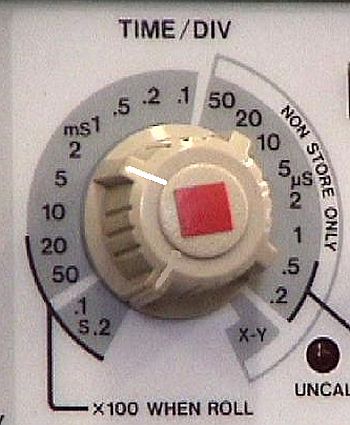Monitoring and measuring a.c.
Alternating Current in UK mains is 230 V with a frequency of 50 Hz. This means that 50 times every second the direction of the current flip flops backwards and forwards. A graph of how a.c. and d.c. compare can be seen below.

From the graph it is possible to see that at each instant the value of the potential difference is constantly changing both in direction and value each second.
As you can see on the graph the peak voltage is greater than 230 V. Why is this the case?
The value of 230 V is the root mean square (rms) value. This is the value which averages out all of the continuous changing voltage and current with a power equivalent to the same d.c. value rather than the peak value.
Vpeak = 325 V
Determining the rms voltage
Attempt to solve the question yourself before clicking the solve button!
The choice of the rms value is choosen because the brightness of a lamp with 230Vrms a.c. is the same brightness as a lamp with 230 V d.c.

Determnation of frequency, peak voltage and r.m.s. values from an oscilloscope
We can use an oscilloscope to determine details of the peak voltage and frequency.

On the controls of an oscilloscope there are dials detailing the values for the size of each division horizontally and vertically. From these settings we can work out the relevant values.
Timebase
The horizontal control is used for time based measurements (timebase). In the diagram above the timebase setting is 5 ms/div. What is the frequency of the wave?

Periodic time for one full wave requires 4 horizontal divisions.
T = 4 x 5 x 10-3 = 0.02 s
f = 50 Hz
Peak Voltage
The vertical divisions are in volts per division (V/div).
The oscilloscope is set on the y-axis to 2V/div. What is the peak voltage, and the r.m.s. voltage?
Vpeak = 3.25 divisions
Vpeak = 3.25 x 2 = 6.5 V
The r.m.s. value can simply be calculated by 0.7 x peak value.
Root Mean Square Current
In any a.c. circuit the constantly changing magnitude of the voltage will result in a constantly changing magnitude of the current since V = IR and V is constantly changing. We know that the Vrms value gives us the same brightness of a lamp with the same d.c. voltage. The Irms current is calculated in the same manner as the voltage and we can see this below:
Calculate the Irms in a series circuit where a 100 Ω resistor is supplied with a peak voltage of 70.7 V. In order to derermin the Irms we need to first calculate the Vrms and then use Ohm's Law, V = IR, to determine the current.
Now that we know the Vrms is 50 V we can substitute that into Ohm's Law to determine the Irms.
Determining an rms current
Attempt to solve the question yourself before clicking the solve button!
Frequency of supply
Attempt to solve the question yourself before clicking the solve button!